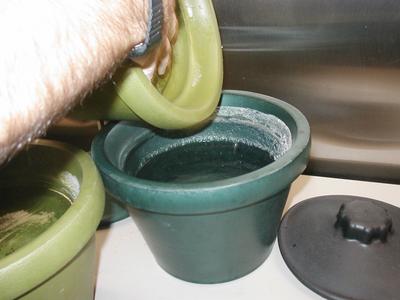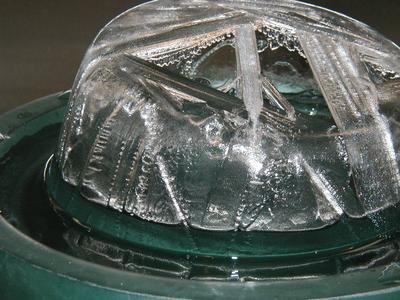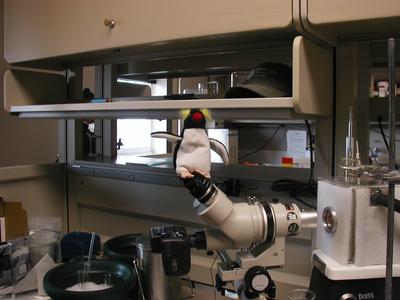
|
|
30 November, 2001

I met with Dr. Jim Raymond and lab assistant Mical Samuelson in the Crary Lab at the McMurdo Research Station. Dr. Jim Raymond, a research scientist with the University of Nevada Las Vegas, is conducting research on sea algae at various locations along the continental coastline of Antarctica. His team travels by helicopter to nearby areas in the vicinity of McMurdo Sound (near Cape Evans and Granite Harbor) to collect sea ice and algae (diatoms) samples from drilled holes in the sea ice. The focus of Dr. Raymond's research is to study the ice active substances (IAS) produced by sea ice diatoms. These substances have the ability to prevent freeze-thaw damage in the cells of algae. I found his research interesting because I was amazed to see algae "surviving" under the ice while at Explorers Cove. How could anything possibly live in the harsh cold climate of Antarctica? By analyzing these substances, Dr. Raymond may possibly determine the makeup of the ice-binding molecules that appear to have antifreeze type proteins similar to the antifreeze properties of the fish that live in the Southern Ocean. These molecules are only associated with algae in icy waters. As the molecules bind to ice crystals, the IAS prevents recrystallization of ice and interferes with crystal growth as it sticks to ice. Ice first grows rapidly and forms tiny micro crystals over hours and days. Little crystals fuse into bigger crystals. During the fusion/ recrystalization process, the cell wall may be damaged. The molecules (glycoproteins), which are part protein and part carbohydrates, may help to preserve the cell in some way, possibly by binding to the ice crystals. Dr. Raymond will study how these molecules affect the diatoms' survival, and how diatoms survive the freeze/thaw process. Dr. Raymond studies algae (diatoms) attached to the bottom of the ice. A jiffy drill is used to go through the ice in order to get algae off the top of the surface as it comes up. Dr. Raymond's team gets the algae growing on the underside of the ice before the ice melts. Seawater is added to prevent the salinity from changing. Dr. Raymond's three-year project will attempt to determine the origin, seasonality, and functions of these molecules. Antarctica has the richest diatom population in the world. Photosynthesis in this part of the world usually starts in late October. (Photosynthesis is the process in which plants containing chlorophyll use energy from the sun to convert carbon dioxide from the air along with water to make simple sugars for food.) Dr. Raymond's study is important because algae is an important base of the food chain. In these Antarctic waters, photosynthesis takes place as light gets through the ice. Snow cover has a big effect: light can still get through two inches of snow cover, but four inches of snow will prevent light from reaching the algae. (Since thicker ice will have fewer algae, Dr. Raymond's team drills through thin ice). A huge bloom of algae will take place in spring. Although 99% of algae cells may die during the winter months, only 1% is needed to survive. Brown algae indicate that the algae is getting and absorbing sunlight. (Black shows 100% efficient light).

These two ice blocks are in the –20 degree freezer at the Crary Lab. After getting the diatom samples from the sea ice, the brown ice is melted to get the brown algae out. It is frozen again at – 20 degrees, then – 5 degrees Fahrenheit. The blocks of ice will be centrifuged (a machine will use centrifugal force to drive out water and brine (salt) in order to leave antifreeze behind). Dr. Raymond's team will study the antifreeze that sticks to the ice. Dr. Raymond explained that the diatoms produce the antifreeze, and it is released from the cells into the briny seawater in which they live. Since it is now outside of the cells, it is said to be extracellular. Dr. Raymond melts the ice, and the cells fall to the bottom because they are heavy. Then the liquid on top is harvested. It has the antifreeze in it. This is frozen into blocks in the first part of the purification process.

Dr. Raymond's team makes ice crystals by freezing water in these pots. An ice crystal from this frozen ice (photo below) will be submerged in a solution of the antifreeze. Dr. Raymond said that the temperature is just low enough for the ice crystal to grow. The antifreeze in solution binds to the ice crystal, which makes the ice grow in funny shapes. The ice grows smoothly without the antifreeze.

Slivers from these beautiful crystals will be used to test the antifreeze in the melted solution.

Dr. Raymond is holding a sliver of an ice crystal at the tip of this instrument to be viewed under the microscope.

"Spike" is checking out the microscope with the ice sliver. Dr. Raymond will purify and analyze ice active substances at the Crary Lab in McMurdo Research Station, as well as send some samples to his home institution for further analysis. Freeze/thaw is bad on organisms, so the molecules in the ice layers where these diatoms are found are essential in preventing freeze/thaw damage and aid in the survival of algae living in extreme cold environments.
Contact the TEA in the field at
.
If you cannot connect through your browser, copy the
TEA's e-mail address in the "To:" line of
your favorite e-mail package.
|
